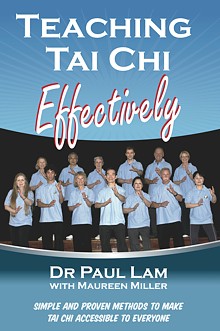Forward – A Review of the Revised and Updated Tai Chi Effectively Book
Forward
This is a timely book, as numerous studies have shown the effectiveness of tai chi in treating common diseases such as depression, osteoarthritis, rheumatoid arthritis, multiple sclerosis, and hypertension. At the same time, Governments are recognising that tai chi can be very good for the public health system, because tai chi itself provides an affordable health-care system for improving wellbeing, treating chronic diseases, enhancing healthy ageing. And tai chi is a natural intervention, which involves self-motivation and participation, thereby empowering people to manage their own health.

This, too, is an exciting time, in which the nurturing light of tai chi is poised to shine brighter and further than ever before. More than ever, there is a huge demand for both good tai chi teachers and effective methods of teaching tai chi. The launching of this book is therefore timely and significant. It is true that there are many excellent books written about how to do tai chi, but good books on how to be an effective tai chi teacher are extremely rare. As someone who enjoys the daily practice of tai chi and qigong for twenty odd years, and teaching these arts on a casual basis for many of those years, I was touched, as I read through this text, by a sense of good fortune to have come across such a useful book.
Tai chi is an ancient art that has a lot more layers of technical and conceptual depth than meet the eye. Dr Lam’s approach to teaching this intricate art is refreshingly simple, heartfelt, and follows the tai chi principle that neither the teaching nor learning should be rushed but rather should flow smoothly with positivity and in small steps. His teaching model is built on the idea that often the most effective systems are the simplest ones. Indeed his Stepwise Method to learning tai chi forms appears so simple that it is surprising how effective it is.
But this book contains much more than how to teach the forms. It is a book about caring for the welfare of the students – and those of the teachers. It emphasises safety as paramount and describes potential risks and safety precautions that all tai chi teachers should be familiar with. It is also a one-stop-shop for anyone wanting to start a tai chi class or tai chi ‘business’, as it covers all the key elements from getting started through to making a success and lifetime enjoyment of the endeavour. Crystallising 30 years of experience of teaching tai chi in many countries and engaging in research and promotion of tai chi for its health benefits, Dr Lam shares his enormous insights into the theories and psychology of teaching, financial considerations, preparing for and leading the class, motivating and retaining the students, as well as other useful tools of the trade.
The chapter on 'Follow Through with Tai Chi Principles' makes particularly interesting and important reading. As Dr Lam puts it, the immense power of tai chi for improving health and inner energy, regardless of variations in styles and forms, derives from a set of essential principles. Leave these principles behind and tai chi becomes no more than the superficial physical gesturing of arms and legs that will bring little of the mind-body benefits that tai chi is so capable of delivering. Concepts such as song (relax, loosening and stretching out), jing (mental quietness and serenity), chen (sinking of qi to the dan tien or qi centre) and huo (agility and ability to move nimbly) are pivotal for the students to understand and apply in their practice; as are the principles of variation in the speed of tai chi movement and the awareness of not stopping. This book is full of such gems.
Teaching is a highly rewarding and imperative activity. This is a gold-standard book will benefit all established and budding tai chi teachers, as well as teachers of many other fields.
Andy Choo is a biomedical researcher who has published over 180 papers in internationally peer-reviewed journals and authored two books. He is a Professor of The Faculty of Medicine at The University of Melbourne in Australia, a Senior Principle Research Fellow of the National Health and Medical Research Council of Australia, and a Fellow of the Australian Academy of Science. He has practiced tai chi and qigong daily for over 20 years, teaches these arts on a casual basis, and is currently engaged in tai chi research.
